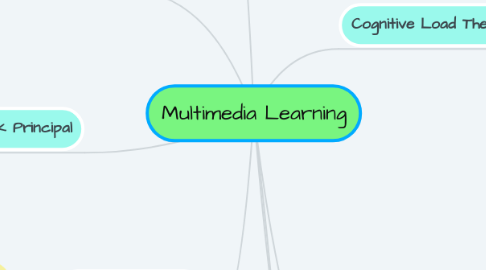
1. Redundancy Principle
1.1. Definition: Applies to instructional situations in which additional information presented to learners is not needed for learning.
1.1.1. Has negative effects on learning.
1.1.2. Such information should be eliminated.
1.1.3. Variations of the effect.
1.1.3.1. Identical information may be presented in two or more different forms of media simultaneously.
1.1.3.2. Unnecessary additional information is presented.
2. Signaling Principle/ Cueing Principle
2.1. Definition: People learn more deeply from a multimedia message when cues are added that guide attention to the relevant elements of the material or highlights the organization of the relevant material.
2.1.1. Crucial for the first steps in multimedia learning.
2.1.2. enables learning from multimedia materials.
2.1.3. What information is attended to is determined by both bottom-up and top-down processing.
3. Feedback Principal
3.1. Definition/Purpose: Novice students learn better with explanatory feedback than with corrective feedback alone.
3.1.1. Explanatory feedback: provides the learner with a principle-based explanation of why his or her answer was correct or incorrect.
3.1.2. Corrective Feedback: Merely informs the learner that his or her response was correct or incorrect.
4. Multiple Representation Principle
4.1. Definition: Occurs when multiple forms of multimedia are utilized to enhance students' comprehension of information
4.1.1. Examples: photographs, diagrams, graphs, maps, pictures, videos, simulations, and animations
4.1.2. Provides students with opportunities to create representations.
4.1.3. Beneficial to multimedia learning.
5. Learner Control Principle
5.1. Definition/Purpose: Used to characterize digital learning environments that allow learners to exert control over instruction by selecting and sequencing its content.
5.1.1. Learner controls the pace at which they progress.
5.1.2. Learners choose among different ways of displaying to-be-learned information.
5.1.3. Contrast of system-controlled environment.
6. Cognitive Load Theory
6.1. Information Processing
6.1.1. Sensory Memory
6.1.1.1. Visual
6.1.1.2. Auditory
6.1.2. Short-Term Memory
6.1.2.1. Temporary Working Memory
6.1.2.2. Rehersal
6.1.2.3. Chunking
6.2. Long-Term Memory
6.2.1. Models of Storage
6.2.1.1. Semantic networks
6.2.1.2. Feature Comparisons
6.2.1.3. Propositional Networks
6.2.1.4. Dual Codes of visual and verbal information
6.2.1.5. Parallel distributed processing
6.3. Situated Cognition
6.3.1. Knowledge is conceived as lived practices
6.3.2. Learning is participation in communities of practice
6.4. Four-Component Design Model
6.4.1. Learning-Task
6.4.2. Part Task Practice
6.4.3. Supportive Information
6.4.4. Procedural Information
7. Split Attention Principle
7.1. Definition: Occurs when learners are required to split their attention and mentally integrate several sources of information.
7.1.1. Each piece of information is essential.
7.1.2. This increases Cognitive Load.
7.1.3. Has a negative impact on learning.
7.1.4. Can be fixed by restructuring information to be integrated.
8. Modality Principle
8.1. Definition: Occurs when a mixed-mode (visual AND auditory) presentation of information is more effective than a single-mode (visual OR auditory) presentation of the same information.
8.1.1. Derives from the split attention effect.
8.1.2. Students learn better when associated statements are narrated rather than presented visually.
8.1.3. Occurs when visual is linked with auditory rather than written.
